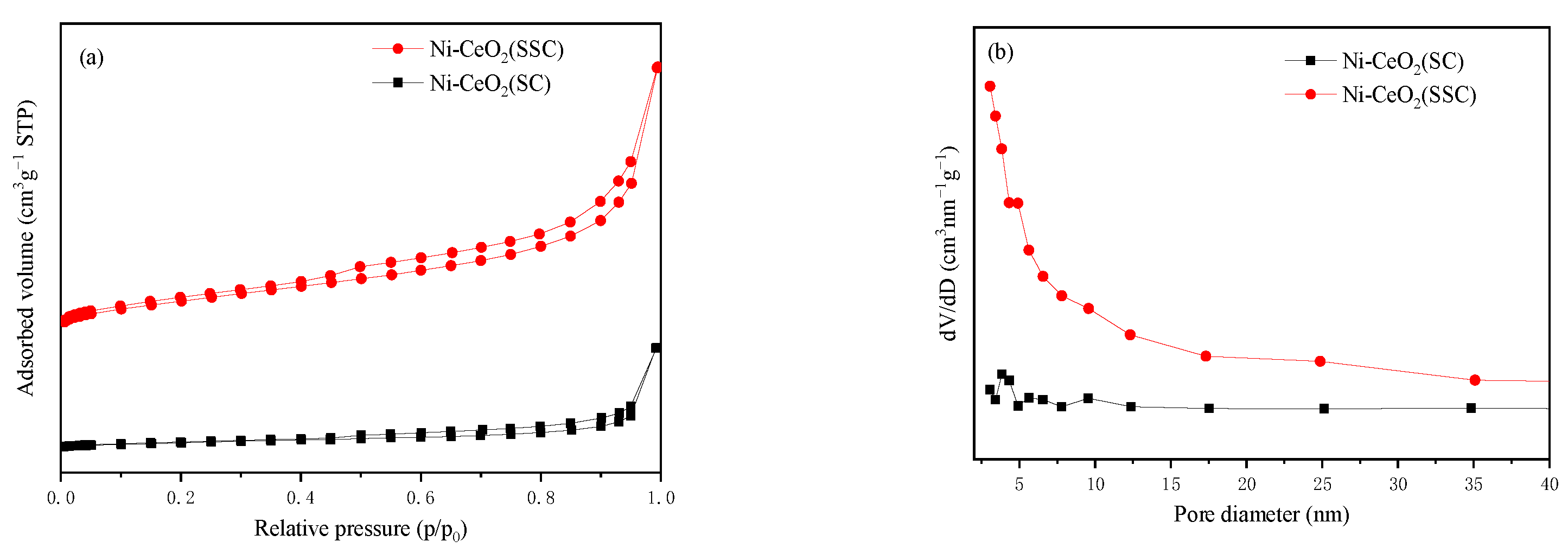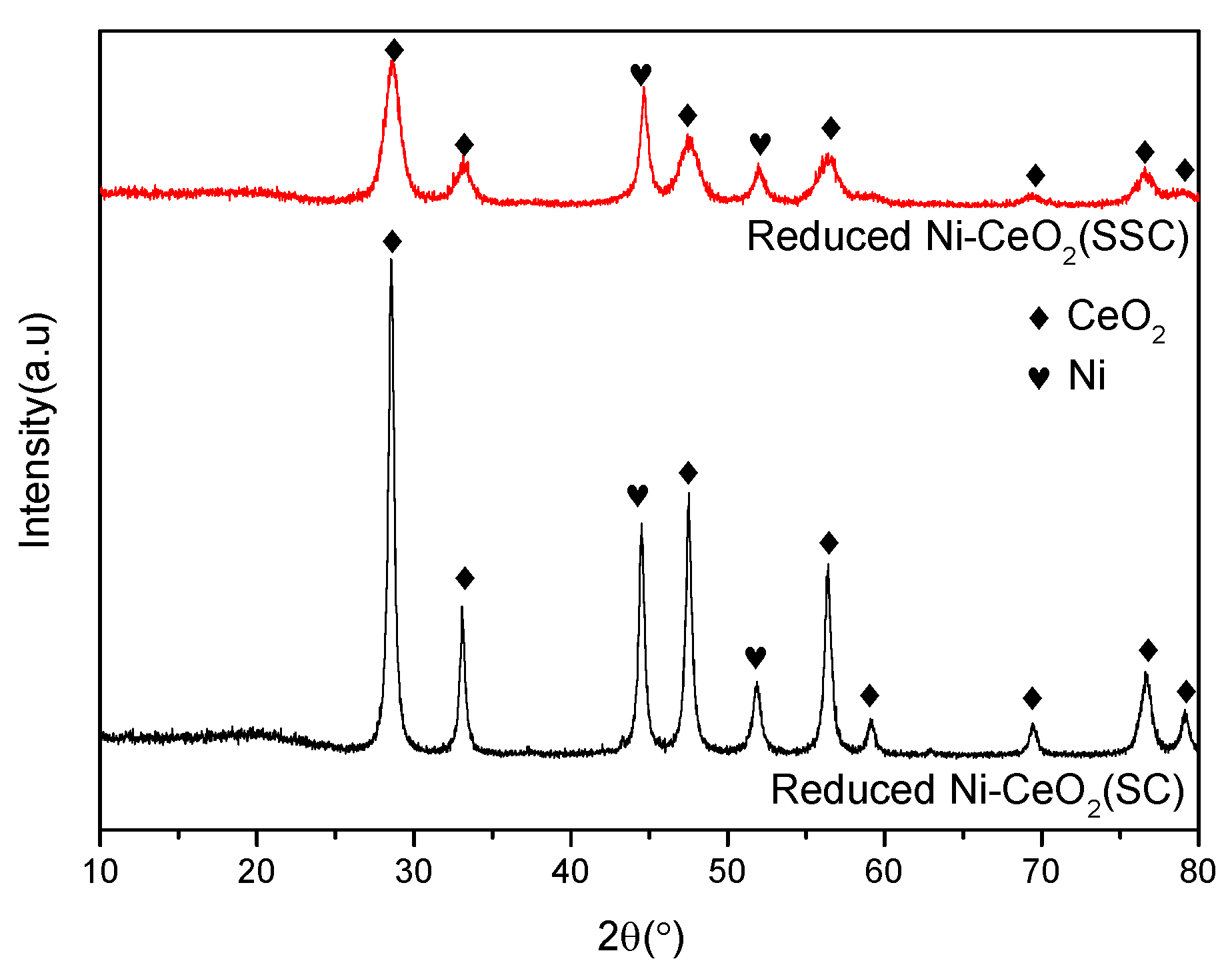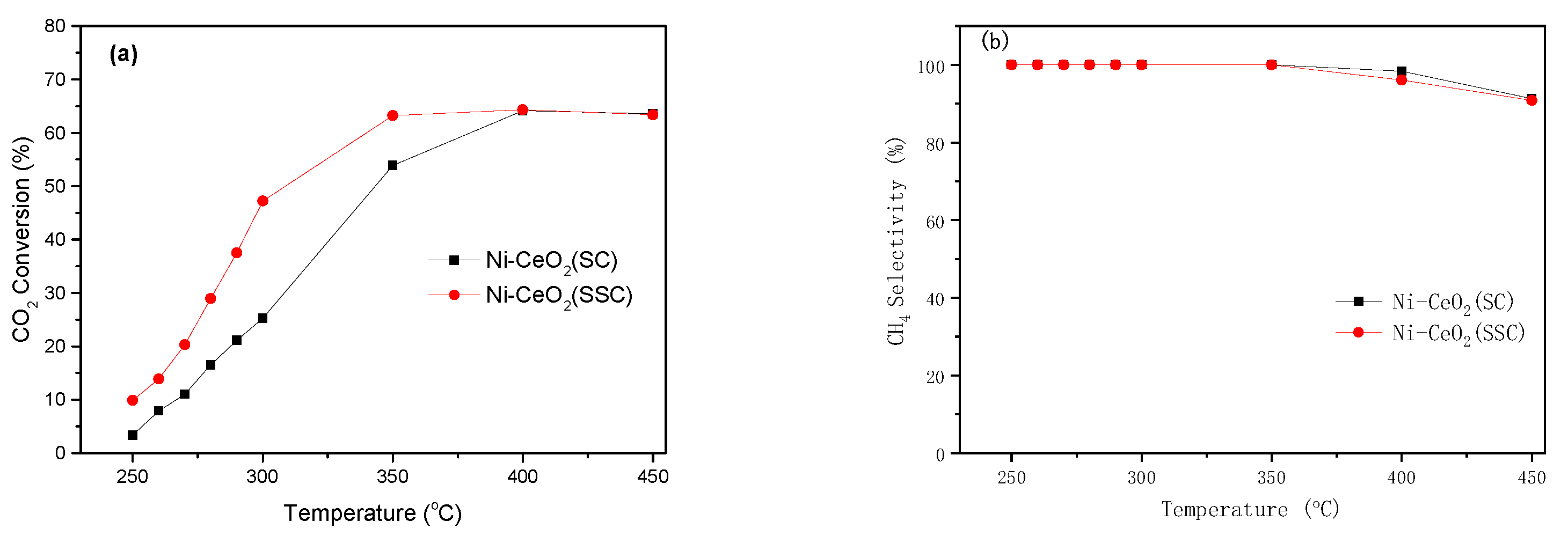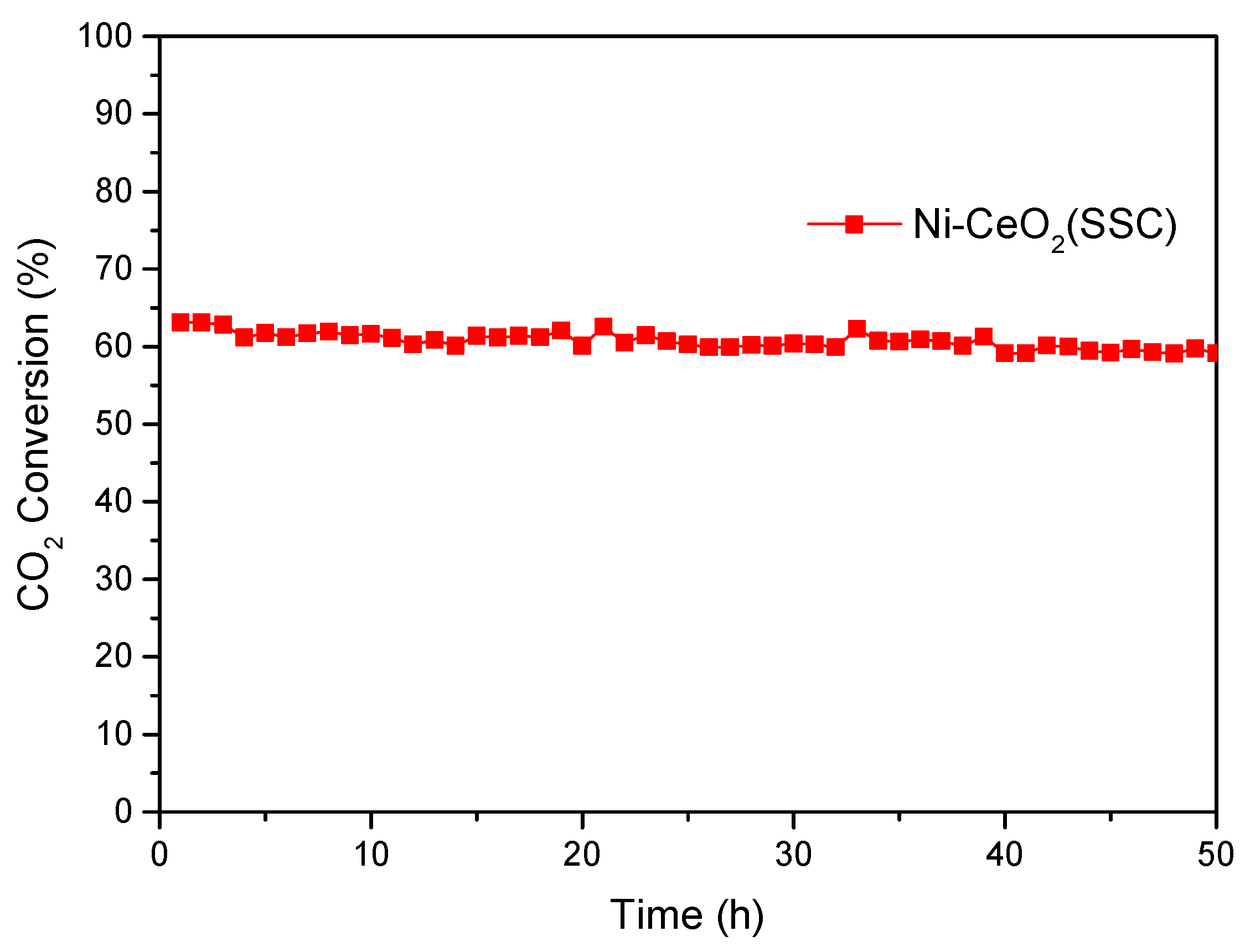Ni-CeO2 Catalyst with High Ni Loading Prepared by Salt-Assisted Solution Combustion for CO2 Methanation
Abstract
:1. Introduction
2. Materials and Methods
2.1. Catalyst Preparation
2.2. Catalyst Characterization
2.3. Catalyst Performance Test
3. Results and Discussion
4. Conclusions
Author Contributions
Funding
Institutional Review Board Statement
Informed Consent Statement
Data Availability Statement
Conflicts of Interest
References
- Nie, W.; Zou, X.; Shang, X.; Wang, X.; Ding, W.; Lu, X. CeO2-assisted Ni nanocatalysts supported on mesoporous γ-Al2O3 for the production of synthetic natural gas. Fuel 2017, 202, 135–143. [Google Scholar] [CrossRef]
- Wang, W.; Wang, S.; Ma, X.; Gong, J. Recent advances in catalytic hydrogenation of carbon dioxide. Chem. Soc. Rev. 2011, 40, 3703–3727. [Google Scholar] [CrossRef] [PubMed] [Green Version]
- Pandey, D.; Ray, K.; Bhardwaj, R.; Bojja, S.; Chary, K.; Deo, G. Promotion of unsupported nickel catalyst using iron for CO2 methanation. Int. J. Hydrog. Energy 2018, 43, 4987–5000. [Google Scholar] [CrossRef]
- Biset-Peiró, M.; Guilera, J.; Zhang, T.; Arbiol, J.; Andreu, T. On the role of ceria in Ni-Al2O3 catalyst for CO2 plasma methanation. Appl. Catal. A Gen. 2019, 575, 223–229. [Google Scholar] [CrossRef]
- Xu, J.; Su, X.; Duan, H.; Hou, B.; Lin, Q.; Liu, X.; Pan, X.; Pei, G.; Geng, H.; Huang, Y. Influence of pretreatment temperature on catalytic performance of rutile TiO2-supported ruthenium catalyst in CO2 methanation. J. Catal. 2016, 333, 227–237. [Google Scholar] [CrossRef]
- Su, X.; Xu, J.; Liang, B.; Duan, H.; Hou, B.; Huang, Y. Catalytic carbon dioxide hydrogenation to methane: A review of recent studies. J. Energy Chem. 2016, 25, 553–565. [Google Scholar] [CrossRef]
- Wang, F.; He, S.; Chen, H.; Wang, B.; Zheng, L.; Wei, M.; Evans, D.G.; Duan, X. Active site dependent reaction mechanism over Ru/CeO2 catalyst toward CO2 methanation. J. Am. Chem. Soc. 2016, 138, 6298–6305. [Google Scholar] [CrossRef]
- Kim, H.Y.; Lee, H.M.; Park, J.-N. Bifunctional mechanism of CO2 methanation on Pd-MgO/SiO2 catalyst: Independent roles of MgO and Pd on CO2 methanation. J. Phys. Chem. C 2010, 114, 7128–7131. [Google Scholar] [CrossRef]
- Wei, W.; Jinlong, G. Methanation of carbon dioxide: An overview. Front. Chem. Sci. Eng. 2011, 5, 2–10. [Google Scholar] [CrossRef]
- Aziz, M.; Jalil, A.; Triwahyono, S.; Mukti, R.; Taufiq-Yap, Y.; Sazegar, M. Highly active Ni-promoted mesostructured silica nanoparticles for CO2 methanation. Appl. Catal. B Environ. 2014, 147, 359–368. [Google Scholar] [CrossRef]
- Zhao, K.; Wang, W.; Li, Z. Highly efficient Ni/ZrO2 catalysts prepared via combustion method for CO2 methanation. J. CO2 Util. 2016, 16, 236–244. [Google Scholar] [CrossRef]
- Tan, J.; Wang, J.; Zhang, Z.; Ma, Z.; Wang, L.; Liu, Y. Highly dispersed and stable Ni nanoparticles confined by MgO on ZrO2 for CO2 methanation. Appl. Surf. Sci. 2019, 481, 1538–1548. [Google Scholar] [CrossRef]
- Atzori, L.; Cutrufello, M.G.; Meloni, D.; Cannas, C.; Gazzoli, D.; Monaci, R.; Sini, M.F.; Rombi, E. Highly active NiO-CeO2 catalysts for synthetic natural gas production by CO2 methanation. Catal. Today 2018, 299, 183–192. [Google Scholar] [CrossRef]
- Ge, Y.; He, T.; Han, D.; Li, G.; Zhao, R.; Wu, J. Plasma-assisted CO2 methanation: Effects on the low-temperature activity of an Ni–Ce catalyst and reaction performance. R. Soc. Open Sci. 2019, 6, 190750. [Google Scholar] [CrossRef] [PubMed] [Green Version]
- Varma, A.; Mukasyan, A.S.; Rogachev, A.S.; Manukyan, K.V. Solution Combustion Synthesis of Nanoscale Materials. Chem. Rev. 2016, 116, 14493–14586. [Google Scholar] [CrossRef] [PubMed]
- Carlos, E.; Martins, R.; Fortunato, E.; Branquinho, R. Solution combustion synthesis: Towards a sustainable approach for metal oxides. Chem.—A Eur. J. 2020, 26, 9099–9125. [Google Scholar] [CrossRef] [PubMed]
- Cross, A.; Roslyakov, S.; Manukyan, K.V.; Rouvimov, S.; Rogachev, A.S.; Kovalev, D.; Wolf, E.E.; Mukasyan, A.S. In situ preparation of highly stable Ni-based supported catalysts by solution combustion synthesis. J. Phys. Chem. C 2014, 118, 26191–26198. [Google Scholar] [CrossRef]
- Ullah, N.; Qu, J.; Li, Z. Enhanced sulfur-resistant methanation performance over MoO3–ZrO2 catalyst prepared by solution combustion method. Appl. Organomet. Chem. 2019, 33, e5022. [Google Scholar]
- Jiang, Y.; Huang, T.; Dong, L.; Qin, Z.; Ji, H. Ni/bentonite catalysts prepared by solution combustion method for CO2 methanation. Chin. J. Chem. Eng. 2018, 26, 2361–2367. [Google Scholar] [CrossRef]
- Abbasian, A.R.; Mahvary, A.; Alirezaei, S. Salt-assisted solution combustion synthesis of NiFe2O4: Effect of salt type. Ceram. Int. 2021, 47, 23794–23802. [Google Scholar] [CrossRef]
- Chen, W.; Li, F.; Yu, J.; Liu, L. A facile and novel route to high surface area ceria-based nanopowders by salt-assisted solution combustion synthesis. Mater. Sci. Eng. B 2006, 133, 151–156. [Google Scholar] [CrossRef]
- Abbasian, A.R.; Rahmani, M. Salt-assisted solution combustion synthesis of nanostructured ZnFe2O4-ZnS powders. Inorg. Chem. Commun. 2020, 111, 107629. [Google Scholar] [CrossRef]
- Zhao, Y.; Jiang, N.; Zhang, X.; Guo, J.; Yang, Q.; Gao, L.; Li, Y.; Ma, T. One-step salt-assisted solution combustion synthesis of Ni-based composites for use as supercapacitor electrodes. J. Alloy. Compd. 2018, 765, 396–404. [Google Scholar] [CrossRef]
- Zhou, G.; Liu, H.; Cui, K.; Jia, A.; Hu, G.; Jiao, Z.; Liu, Y.; Zhang, X. Role of surface Ni and Ce species of Ni/CeO2 catalyst in CO2 methanation. Appl. Surf. Sci. 2016, 383, 248–252. [Google Scholar] [CrossRef]
- Guo, Y.; Zou, J.; Shi, X.; Rukundo, P.; Wang, Z.-j. A Ni/CeO2–CDC-SiC catalyst with improved coke resistance in CO2 reforming of methane. ACS Sustain. Chem. Eng. 2017, 5, 2330–2338. [Google Scholar] [CrossRef]
- Zhou, G.; Liu, H.; Cui, K.; Xie, H.; Jiao, Z.; Zhang, G.; Xiong, K.; Zheng, X. Methanation of carbon dioxide over Ni/CeO2 catalysts: Effects of support CeO2 structure. Int. J. Hydrog. Energy 2017, 42, 16108–16117. [Google Scholar] [CrossRef]
- Tada, S.; Shimizu, T.; Kameyama, H.; Haneda, T.; Kikuchi, R. Ni/CeO2 catalysts with high CO2 methanation activity and high CH4 selectivity at low temperatures. Int. J. Hydrog. Energy 2012, 37, 5527–5531. [Google Scholar] [CrossRef]
- Tada, S.; Ikeda, S.; Shimoda, N.; Honma, T.; Takahashi, M.; Nariyuki, A.; Satokawa, S. Sponge Ni catalyst with high activity in CO2 methanation. Int. J. Hydrog. Energy 2017, 42, 30126–30134. [Google Scholar] [CrossRef]
- Ye, R.-P.; Li, Q.; Gong, W.; Wang, T.; Razink, J.J.; Lin, L.; Qin, Y.-Y.; Zhou, Z.; Adidharma, H.; Tang, J. High-performance of nanostructured Ni/CeO2 catalyst on CO2 methanation. Appl. Catal. B Environ. 2020, 268, 118474. [Google Scholar] [CrossRef]
- Rui, N.; Zhang, X.; Zhang, F.; Liu, Z.; Cao, X.; Xie, Z.; Zou, R.; Senanayake, S.D.; Yang, Y.; Rodriguez, J.A. Highly active Ni/CeO2 catalyst for CO2 methanation: Preparation and characterization. Appl. Catal. B Environ. 2021, 282, 119581. [Google Scholar] [CrossRef]
- Tada, S.; Nagase, H.; Fujiwara, N.; Kikuchi, R. What are the best active sites for CO2 methanation over Ni/CeO2? Energy Fuels 2021, 35, 5241–5251. [Google Scholar] [CrossRef]
- Lee, S.M.; Lee, Y.H.; Moon, D.H.; Ahn, J.Y.; Nguyen, D.D.; Chang, S.W.; Kim, S.S. Reaction mechanism and catalytic impact of Ni/CeO2–x catalyst for low-temperature CO2 methanation. Ind. Eng. Chem. Res. 2019, 58, 8656–8662. [Google Scholar] [CrossRef]
- Atzori, L.; Cutrufello, M.G.; Meloni, D.; Monaci, R.; Cannas, C.; Gazzoli, D.; Sini, M.F.; Deiana, P.; Rombi, E. CO2 methanation on hard-templated NiO-CeO2 mixed oxides. Int. J. Hydrog. Energy 2017, 42, 20689–20702. [Google Scholar] [CrossRef]
- Kloetstra, K.; Zandbergen, H.; Van Koten, M.; Van Bekkum, H. Thermoporometry as a new tool in analyzing mesoporous MCM-41 materials. Catal. Lett. 1995, 33, 145–156. [Google Scholar] [CrossRef]
- Ocampo, F.; Louis, B.; Roger, A.-C. Methanation of carbon dioxide over nickel-based Ce0.72Zr0.28O2 mixed oxide catalysts prepared by sol–gel method. Appl. Catal. A Gen. 2009, 369, 90–96. [Google Scholar] [CrossRef]
- Holzwarth, U.; Gibson, N. The Scherrer equation versus the ‘Debye-Scherrer equation’. Nat. Nanotechnol. 2011, 6, 534. [Google Scholar] [CrossRef]
- Kang, W.; Varma, A. Hydrogen generation from hydrous hydrazine over Ni/CeO2 catalysts prepared by solution combustion synthesis. Appl. Catal. B Environ. 2018, 220, 409–416. [Google Scholar] [CrossRef]
- Shan, W.; Luo, M.; Ying, P.; Shen, W.; Li, C. Reduction property and catalytic activity of Ce1− XNiXO2 mixed oxide catalysts for CH4 oxidation. Appl. Catal. A Gen. 2003, 246, 1–9. [Google Scholar] [CrossRef]
- Liu, H.; Zhao, C.; Wang, L. Mesoporous Ni–CeO2 Catalyst with Enhanced Selectivity and Stability for Reverse Water–Gas Shift Reaction. J. Chem. Eng. Jpn. 2018, 49, 161–165. [Google Scholar] [CrossRef]






| Sample | SBET (m2/g) | Pore Volume (cm3/g) | Pore Size (nm) |
|---|---|---|---|
| Ni-CeO2(SC) | 11.2 | 0.07 | 23.8 |
| Ni-CeO2(SSC) | 77.5 | 0.18 | 9.9 |
| Samples | Ni (nm) a | CeO2 (nm) a | SNi (m2/gcat) b |
|---|---|---|---|
| Ni-CeO2(SC) | 21.4 | 18.8 | 5.87 |
| Ni-CeO2(SSC) | 7.2 | 11.2 | 11.45 |
Publisher’s Note: MDPI stays neutral with regard to jurisdictional claims in published maps and institutional affiliations. |
© 2022 by the authors. Licensee MDPI, Basel, Switzerland. This article is an open access article distributed under the terms and conditions of the Creative Commons Attribution (CC BY) license (https://creativecommons.org/licenses/by/4.0/).
Share and Cite
Han, C.; Cao, Z.; Yang, J.; Lu, X.; Liu, H.; Jin, Z.; Zhang, Y.; Yang, S.; Zheng, X.; Wang, L. Ni-CeO2 Catalyst with High Ni Loading Prepared by Salt-Assisted Solution Combustion for CO2 Methanation. Crystals 2022, 12, 702. https://doi.org/10.3390/cryst12050702
Han C, Cao Z, Yang J, Lu X, Liu H, Jin Z, Zhang Y, Yang S, Zheng X, Wang L. Ni-CeO2 Catalyst with High Ni Loading Prepared by Salt-Assisted Solution Combustion for CO2 Methanation. Crystals. 2022; 12(5):702. https://doi.org/10.3390/cryst12050702
Chicago/Turabian StyleHan, Cui, Zhongqi Cao, Jiliang Yang, Xinkang Lu, Hui Liu, Zheyu Jin, Ying Zhang, Shuqing Yang, Xianmin Zheng, and Luhui Wang. 2022. "Ni-CeO2 Catalyst with High Ni Loading Prepared by Salt-Assisted Solution Combustion for CO2 Methanation" Crystals 12, no. 5: 702. https://doi.org/10.3390/cryst12050702
APA StyleHan, C., Cao, Z., Yang, J., Lu, X., Liu, H., Jin, Z., Zhang, Y., Yang, S., Zheng, X., & Wang, L. (2022). Ni-CeO2 Catalyst with High Ni Loading Prepared by Salt-Assisted Solution Combustion for CO2 Methanation. Crystals, 12(5), 702. https://doi.org/10.3390/cryst12050702







